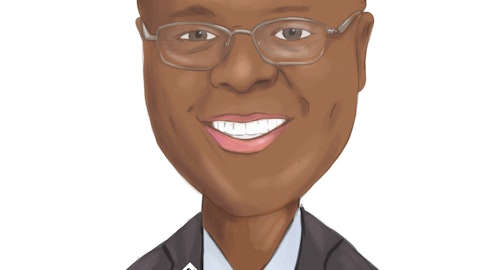HomeStreet, Inc. (NASDAQ:HMST) Q4 2022 Earnings Call Transcript January 30, 2023
Operator: Good afternoon. Thank you for attending today’s Fourth Quarter 2022 Earnings Release Call for HomeStreet Bank. Joining us on this call is Mark Mason, CEO, President, and Chairman of the Board. I would now like to pass the conference over to our host, Mark Mason. Please go ahead.
Mark Mason: Hello, and thank you for joining us for our 2022 fourth quarter earnings call. Before we begin, I’d like to remind you that our detailed earnings release and an accompanying investor presentation were filed with the SEC on Form 8-K on Friday and are now available on our website at ir.homestreet.com under the News & Events link. In addition, a recording and a transcript of this call will be available at the same address following our call. Please note that during our call today, we will make certain predictive statements that reflect our current views and expectations about the company’s performance and financial results. These are likely forward-looking statements that are made subject to the safe harbor statements included in Friday’s earnings release, our investor deck, and the risk factors disclosed in our other public filings.
Additionally, reconciliations to non-GAAP measures referred to on our call today can be found in our earnings release and investor deck available on our website. Joining me today is our Chief Financial Officer, John Michel, John will briefly discuss our financial results, and then I’d like to give you an update on our results of operations and our outlook going forward. John?
John Michel: Thank you, Mark. Good morning to everyone, and thank you for joining us. In the fourth quarter of 2022, our net income was $8.5 million or $0.45 per share as compared to net income of $20.4 million or $1.08 per share in the third quarter of 2022. For the full year 2022, our net income was $67 million or $3.49 per share. In the fourth quarter of 2022, our annualized return on average tangible equity was 6.4%. Our annualized return on average assets was 36 basis points and our efficiency ratio was 76.2%. These results reflect the adverse impact of the significant increase in short-term interest rates on our business. For the full-year 2022, our return on average tangible equity was 11.5%. Our return on average assets was 79 basis points and our efficiency ratio was 72.4%.
Our net interest income in the fourth quarter of 2022 was $7.3 million lower than the third quarter of 2022, due to a decrease in our net interest margin from 3% to 2.53%. The decrease in our net interest margin was due to a 90 basis point increase in the cost of interest bearing liabilities, which was partially offset by a 29 basis point increase in the yield on interest earning assets. Yields on interest earning assets increased as yields on adjustable rate loans were higher due to increases in the index and which their pricing is based. The increase in the cost of interest bearing liabilities was due to higher deposit costs, higher borrowing costs and an increase in the proportion of higher cost borrowings used as sources of funding. Our cost of borrowings increased 150 basis points during the fourth quarter, while the cost of deposits increased 58 basis points.
Additionally, our average borrowings increased by $187 million. Our effective tax rate the fourth quarter and full-year for 2022 was 23.7% and 21.4% respectively. In 2023, our expected tax rate is expected to be approximately 23%. A $3.8 million provision for credit losses was recorded during the fourth quarter of 2022, compared to no provision in the third quarter of 2022. The provision recorded in the fourth quarter was primarily due to the growth in our loan portfolio and a $2.2 million increase in the collateral qualitative factor in our allowance for credit losses. This increase in the qualitative collateral risk is related to projection declines in future home prices. Going forward, we expect the ratio of our allowance for credit losses to our loans held for investment portfolio to remain relatively stable and provisioning in future periods to generally reflect changes in the balance of our loans held for investment, assuming our history of minimal charge-offs continues.
Our ratio of non-performing assets to total assets remained low at 13 basis points, declining from 15 basis points last quarter. The decrease in non-interest income in the fourth quarter of 2022 as compared to the third quarter of 2022 was primarily due to a decrease in other income due to a $4.3 million gain on sale of five eastern Washington branches reported in the third quarter. The $0.5 million increase in non-interest expense in the fourth quarter of 2022 as compared to the third quarter of 2022 was primarily due to higher information services costs related to the maintenance and replacement of our ATMs, higher FDIC fees resulting from our larger deposit base, which were offset by lower medical benefit costs and lower commission and bonus expenses.
Consistent with prior years, we expect seasonal increases in compensation and benefit costs to occur in the first quarter of 2023 related to wage increases and seasonal increases in benefit costs. I will now turn the call over to Mark.
Mark Mason: Thank you, John. I’d like to start my remarks today by acknowledging the challenges presented by the significant increase in short-term interest rates this year. We along with certain other peers with similar lending, deposit, and funding structures have been more adversely impacted than other banks during this period. Nearly all banks, however, have seen deposit outflows and rising rates on interest bearing deposits. Our interest sensitive deposits declined as customers move funds to higher yielding products both at our bank and at other banks and brokerage firms. Attractive rates on treasury securities and non-bank money market funds have also created meaningful competition. We’ve also experienced this cyclical downturn in commercial real estate and single family mortgage loan volume, which fell to historically low levels in the fourth quarter.
We have made significant improvements over the last several years in reducing the sensitivity of our company to cyclical interest rate cycles through downsizing our mortgage banking business in growing our non-interest bearing and other core deposits. Despite those changes, our revenues have been meaningfully impacted by the historically significant increase in interest rates by the Federal Reserve. We expect the current pressure on our revenues both on net interest income and non-interest income will be greatest during the first quarter of this year and then begin to ease as more of our mitigation actions fully take hold. These expectations assume among other things that; one, short-term interest rates begin to stabilize in early 2023 in-line with current market expectations; two, we continue to have success in growing deposits with promotional CDs and other products; and three, we complete our Southern California branch acquisition as anticipated this quarter.
During the last six months, we have taken a number of steps to reduce the pressure on our funding base. Including significantly reducing our level of loan originations, introducing promotional price deposit products, which allow us to attract and retain deposits without repricing our existing interest-bearing deposit base and entering into $1 billion of fixed rate federal home loan bank advances in the fourth quarter. We extended the maturities of this $1 billion of FHLB advances to hedge the still unknown risk associated with increasing interest rates and an unknown terminal federal funds rate. These pressures on our funding base have resulted in reductions and our net interest margin, which are expected to continue the trough in the first quarter of 2023.
We expect this to be the low point in our net interest margin assuming short-term interest rates stabilize in the first quarter and we complete our acquisition of three California branches among other things. In addition to the above, we have taken steps to reduce staffing levels in-line with our reduced loan production activity and reduce controllable expenses to the extent possible without damaging our business. In this regard, full-time equivalent employees ended the year at 913, down from 970 at the beginning of the year. Despite the above challenges, we believe we are positioned to resume growing our balance sheet and increasing our earnings once short-term rates stabilize and uncertainty is removed from the interest rate markets. In the fourth quarter, we recorded a $3.8 million addition to our allowance for credit losses.
As John mentioned, this addition primarily relates portfolio growth and additions to a qualitative component of our ACL. Charge-offs in the quarter were only $300,000 approximately and non-performing assets fell as John mentioned, 2.13% of total assets. Credit quality remained strong and we currently do not see any meaningful credit challenges on the horizon. Our portfolio is well diversified with our highest concentration in Western States multifamily loans, one of the lowest risk loan types historically. Our delinquencies, non-performing assets, and classified assets remain at historically low levels. Our portfolio is conservatively underwritten with a very low expected loss potential. I remain very confident of HomeStreet’s credit quality.
During the fourth quarter, we grew our loan portfolio by $209 million and year to date our loan portfolio has grown by $1.9 billion. This growth was accelerated by a historically low level of loan prepayments, particularly in our multifamily portfolio, the largest part of our portfolio today. Today, we are limiting loan portfolio growth. We are also experiencing for loans mostly due to uncertainty regarding the economy and the overall higher level of interest rates. Accordingly, we are anticipating only a modest increase at our overall loan portfolio in 2023. As I’ve discussed, due to core deposit outflow, we funded our loan growth last year initially with wholesale funding both FHLB advances and broker deposits. We have been replacing our wholesale funding with lower cost promotional deposit products, primarily certificates of deposit.
As of 12/31/2022, we had raised $1.4 billion in our promotional deposit products. We are fortunate to have a valuable retail deposit franchise with customers who will invest in certificates of deposit and money market deposit accounts at rates well below brokerage money market funds, treasuries, and wholesale borrowing rates. Additionally, based on our experience, we expect many of these new promotional deposit customers will convert to full relationship, core deposit customers over time. In addition to our ongoing organic deposit gathering, we are acquiring three retail deposit branches from Union Bank, U.S. Bank. In Southern California they currently include approximately $450 million of deposits and $22 million in loans. 83% of the deposits are consumers, and 39% of the deposits are non-interest bearing.

Pixabay/Public Domain
The weighted average rate today for the interest-bearing deposits is approximately 16 basis points. We are excited about this opportunity to expand our footprint in the Southern California market. We anticipate the closing to occur this quarter as we’ve stated. The single family mortgage industry remains in the midst of the most difficult stage of the mortgage banking cycle. While we in industry forecasts expected 2023 loan volume to be well below 2022, we do expect loan volume to recover somewhat from the extremely low levels of the second half of last year. While it’s too early in the year to have much confidence in this year’s forecast, we do know from history that the mortgage market does not stay at low origination volumes very long. This is due in-part to annual population growth in-part to the normalization of housing prices in relation to financing costs and in-part to the ongoing low levels of new and resale homes for sale in relation to demand.
We also continue to benefit from the origination of home equity lines of credit for our loan portfolio, which today carry interest rates of between 7% and 9%. At December 31, 2022, our accumulated other comprehensive income balance, which is a component of our shareholders’ equity was a negative $100 million. The change year to date represents a sizable $6.44 reduction to our tangible book value per share. As I’m sure all of you know by now, while this negative AOCI balance does impact the level of our tangible capital, it is not a permanent impairment in the value of our equity, it has no impact on our regulatory capital levels. We have reduced the impact of current and future additions to negative AOCI by taking opportunities to sell certain longer duration securities and by other shorter duration securities, increasing returns and reducing duration.
Additionally, today we buy shorter duration, lower risk weighted securities when replacing portfolio runoff. The OCI related write-downs of our securities portfolio will be advertised back to us over time as the bonds mature or repay. And should interest rates decline in the future, securities valuations will improve and the OCI write-downs will reverse and restore our tangible capital. Given the earnings and cash flow of our bank, we don’t anticipate needing to sell any of these securities to meet our cash needs. So, we don’t anticipate realizing these temporary write-downs. While our lower level of profitability is less than adequate to us, it’s been materially driven by the exogenous REIT’s interest rate environment. Fortunately, current consensus expectations point to a light at the end of the tunnel as it relates to future rate increases.
Indeed, after four straight 75 basis point rate hikes through November of last year, the Fed followed in December with a lower hike of 50 basis points. And market expectations are now centered on only a 25 basis point hike for the Fed meeting this Wednesday with potentially only one or possibly two additional 25 basis point hikes for March and May meetings. We look forward to what even in an environment of stable rates, whenever that comes, can provide for improved financial performance for our bank. On various earnings calls over the preceding quarters and years, I have shared certain profitability and efficiency targets, which we were both striving for and expecting to achieve based upon information available to us at the time. Of course, those financial targets always came with the customary caveats related to factors, related to cooperating interest rate and economic environments among other factors, which could impact our ability to achieve them.
It should be very clear from our current results how we have been negatively affected by the current environment. The pace and magnitude of rate increases and the associated unpredictability on our funding composition and costs, as well as on certain of our revenue streams may continue to provide guidance on the timing, and levels of financial targets too difficult at this time. For now, we feel we need to defer providing any near term financial performance targets. We expect to return to such guidance after the current dramatic interest rate and economic volatilities have substantially subsided. Our long term goals to meet or exceed our peers with respect to financial performance remain. However, we must acknowledge the relative disadvantages of our existing model to an environment such as the one we are experiencing today.
It is important to note that while this period of lower earnings is painful, and unexpected to a degree, our higher than expected earnings in both 2020 and 2021 was similarly great and unexpected. The current structure that makes our bank more sensitive to cyclical changes in interest rates allows us to over earn in declining rate environments. And while we have worked to reduce this cyclicality, it is important to acknowledge our through the cycle earnings. I share these thoughts not to excuse our current low level of earnings, but to put them in perspective. But again, clearly our work is not finished as the current level of earnings is not acceptable to us. With that, this concludes our prepared comments today and we appreciate your attention.
John and I will be happy to answer any questions you have at this time.
See also 10 Dumbest Companies to Invest In and Top 25 Agrochemical Companies in the World.
Q&A Session
Follow Homestreet Inc. (NASDAQ:HMST)
Follow Homestreet Inc. (NASDAQ:HMST)
Operator: First question is from the line of Matthew Clark with Piper Sandler. Your line is now open.
Matthew Clark: Good morning. Mark and John.
Mark Mason: Good morning.
Matthew Clark: Just first one, around the margin outlook for the upcoming quarter at least to gain some visibility, do you happen to have the average margin in the month of December and the spot rate on deposits at the end of the year, either interest bearing or total?
Mark Mason: We don’t separately disclose margin by month, sorry, Matt. You should assume it was lower than the average, right, given the December additional 50 basis point move by the Fed. And a full month impact of the November decline. Plus, in late November, that’s the point at which we extended and fixed the maturities on that $1 billion of FHLB advances. So, all of that’s going to have a full quarters impact in the first quarter. The ending deposit costs, can we disclose that, John or just the average?
John Michel: We do in the charts.
Mark Mason: Can we direct Matt to that?
John Michel: Yes, I’m going through the pages. It’s on Page 10 of the investor presentation book.
Matthew Clark: Okay. I can look it up. Thanks. And then just on the Union Bank transaction, that’s down from $490 million, I guess what are you assuming for attrition, you know, from that and then, you know, the cost sounds still pretty low. I guess what are your thoughts are on, kind of the cost increase there assuming there’s some migration?
Mark Mason: It’s hard to estimate what runoff we might experience. Our history with these acquisitions has been that we’ve experienced no material runoff. Now, this is a different time with respect to rates and with respect to alternative investments for folks, but when we first negotiated this transaction, the balances in these deposit accounts were approximately what they are today, and the deposits actually increased somewhat through the third quarter. So, they’ve, sort of normalized. I think everyone saw some runoff in the fourth quarter. We are hoping to have minimal runoff for a couple of reasons. One, we have historically not experienced much. But two, we’re going to be giving these folks an opportunity to increase their rates.
Many of these folks transfer over to similar accounts with slightly higher rates, our rack rates, which are not our promotional rates, which are a little higher than their existing rates. And we have the promotional rate products available to them, which are at rates substantially higher than Union Bank today in nearly all cases. Additionally, the rates and terms on many of our basic check-in products are better, particularly better on the business side. Things like the analysis credit and so on. So, we don’t have a lot of basis to make a really well informed estimate of potential runoff. We like our history. We like the feedback that we have gotten from the employees of these branches about their excitement to join HomeStreet as opposed to a much larger bank.
They believe we fit well with their customer base. And we think they’ve been sharing that with their customers. And so, we have our fingers crossed here.





